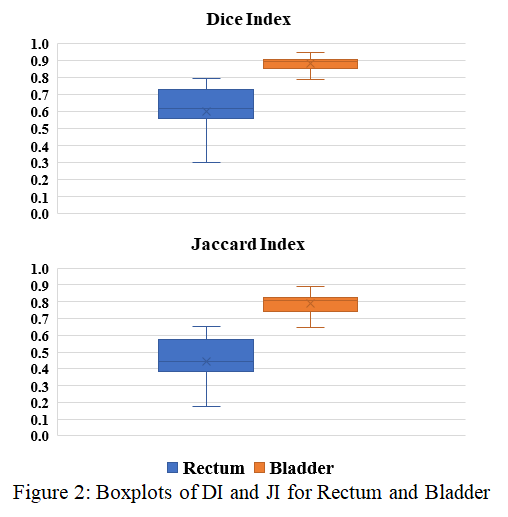Atlas based auto-segmentation in the delineation of rectum and bladder in intrauterine brachytherapy
MO-0297
Abstract
Atlas based auto-segmentation in the delineation of rectum and bladder in intrauterine brachytherapy
Authors: Paolo Caricato1,2, Sofia Meregalli3, Sara Trivellato1, Elisa Bonetto3, Valeria Faccenda1,2, Denis Panizza1,4, Stefano Arcangeli3,4, Elena De Ponti1,4
1ASST Monza, Medical Physics Department, Monza, Italy; 2University of Milan, Department of Physics, Milan, Italy; 3ASST Monza, Department of Radiation Oncology, Monza, Italy; 4University of Milan Bicocca, School of Medicine and Surgery, Milan, Italy
Show Affiliations
Hide Affiliations
Purpose or Objective
Artificial intelligence (AI) has been applied to several
aspects of radiation oncology practice but its role in brachytherapy is scarcely
discussed. On the other hand, there has been an interest renewal in
brachytherapy as a crucial part of curative
radiation therapy for cervix cancer. Manual contouring in gynecological intrauterine brachytherapy (IB) treatment
planning is critical and time-consuming due to a new implant for each fraction,
generally once a week for 4-5 weeks. This study evaluated the feasibility of
atlas-based auto-segmentation (ABAS, Elekta, Stockholm) in the delineation of rectum
and bladder in cervical cancer patients during IB planning.
Material and Methods
At our Institution, the IB procedure requires empty
rectum and bladder filling (100 ml of saline solution) through a urethral
catheter before each CT scan and treatment fraction. Ten different IB patients treated
in 2020 have been retrospectively selected. Contours for bladder and rectum,
carefully defined by two skilled radiation oncologists, were used to create an
atlas library in ABAS. Organs at risks (OARs) contours were generated in ABAS on
16 planning CTs of 4 IB treated patients (January-April 2021). The contour
comparison was performed using the Hausdorff distance (HD), the Mean Distance
to Agreement (MDA), the Dice similarity Index (DI), and the Jaccard Index (JI). The results were compared performing the Wilcoxon
Mann Whitney test to assess statistical significance (α=0.05).
Results
The auto-segmentation process requested about 4
minutes for each CT set. Figures 1 and 2 show the geometrical metric results. ABAS
best results have been recorded in the bladder contouring. The median HD, MDA, DI,
and JI values for the rectum were 24.27 mm [13.04 - 35.20 mm], 4.55 mm [1.96 - 8.59
mm], 0.61 [0.30 - 0.79], and 0.44 [0.18 - 0.65], respectively; while the median
metric values for the bladder were 12.18 mm [6.00 - 27.06 mm], 1.53 mm [0.87 -
2.67 mm], 0.89 [0.79 - 0.94], and 0.81 [0.65 - 0.89], respectively. The bladder
and rectum results showed a statistically significant difference (p <<
0.05) for all the studied metrics. The mean standard deviation of HD, MDA, DI,
and JI metrics for a single patient was 5.23 mm, 1.08 mm, 0.07, and 0.07 for the
rectum, while the values for the bladder were 3.43 mm, 0.31mm, 0.02, and 0.03, respectively.


Conclusion
In these preliminary results,
bladder segmentation showed a higher accuracy compared to rectum segmentation
with smaller inter-fractions variation for a single patient. The suboptimal
results for the rectum could partially be explained by different organ
preparation: the emptying of the rectum was self-regulated by patients at home,
while the bladder was filled by a standard procedure in our Department. On the
other hand, intra-patient variability is limited. The implementation of ABAS
with manual adjustments in IB daily clinical practice could reduce time
consumption, however, further implementations and investigations of AI are
needed.